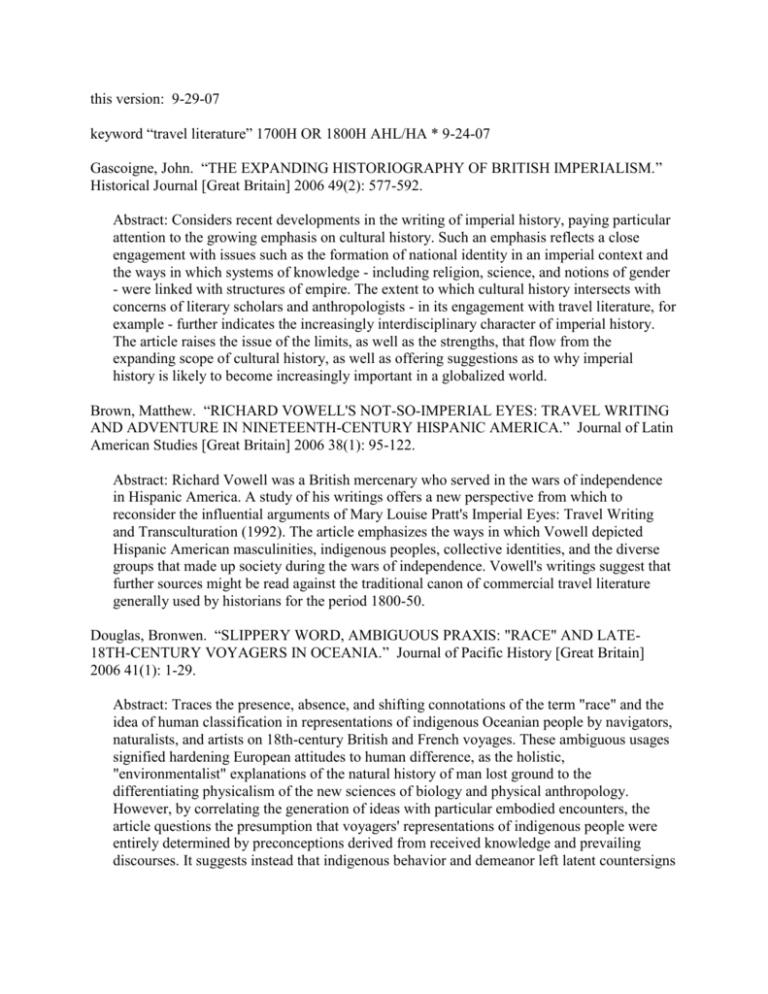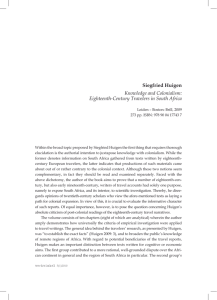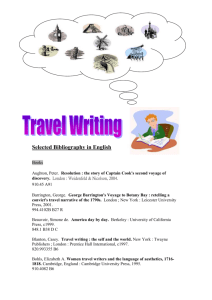articles on travel literature
advertisement

this version: 9-29-07 keyword “travel literature” 1700H OR 1800H AHL/HA * 9-24-07 Gascoigne, John. “THE EXPANDING HISTORIOGRAPHY OF BRITISH IMPERIALISM.” Historical Journal [Great Britain] 2006 49(2): 577-592. Abstract: Considers recent developments in the writing of imperial history, paying particular attention to the growing emphasis on cultural history. Such an emphasis reflects a close engagement with issues such as the formation of national identity in an imperial context and the ways in which systems of knowledge - including religion, science, and notions of gender - were linked with structures of empire. The extent to which cultural history intersects with concerns of literary scholars and anthropologists - in its engagement with travel literature, for example - further indicates the increasingly interdisciplinary character of imperial history. The article raises the issue of the limits, as well as the strengths, that flow from the expanding scope of cultural history, as well as offering suggestions as to why imperial history is likely to become increasingly important in a globalized world. Brown, Matthew. “RICHARD VOWELL'S NOT-SO-IMPERIAL EYES: TRAVEL WRITING AND ADVENTURE IN NINETEENTH-CENTURY HISPANIC AMERICA.” Journal of Latin American Studies [Great Britain] 2006 38(1): 95-122. Abstract: Richard Vowell was a British mercenary who served in the wars of independence in Hispanic America. A study of his writings offers a new perspective from which to reconsider the influential arguments of Mary Louise Pratt's Imperial Eyes: Travel Writing and Transculturation (1992). The article emphasizes the ways in which Vowell depicted Hispanic American masculinities, indigenous peoples, collective identities, and the diverse groups that made up society during the wars of independence. Vowell's writings suggest that further sources might be read against the traditional canon of commercial travel literature generally used by historians for the period 1800-50. Douglas, Bronwen. “SLIPPERY WORD, AMBIGUOUS PRAXIS: "RACE" AND LATE18TH-CENTURY VOYAGERS IN OCEANIA.” Journal of Pacific History [Great Britain] 2006 41(1): 1-29. Abstract: Traces the presence, absence, and shifting connotations of the term "race" and the idea of human classification in representations of indigenous Oceanian people by navigators, naturalists, and artists on 18th-century British and French voyages. These ambiguous usages signified hardening European attitudes to human difference, as the holistic, "environmentalist" explanations of the natural history of man lost ground to the differentiating physicalism of the new sciences of biology and physical anthropology. However, by correlating the generation of ideas with particular embodied encounters, the article questions the presumption that voyagers' representations of indigenous people were entirely determined by preconceptions derived from received knowledge and prevailing discourses. It suggests instead that indigenous behavior and demeanor left latent countersigns in the language, tone, and content of such travel literature and art - on which the emergent metropolitan science of man drew heavily to justify its deductions. Sassi, Jonathan D. “AFRICANS IN THE QUAKER IMAGE: ANTHONY BENEZET, AFRICAN TRAVEL NARRATIVES, AND REVOLUTIONARY-ERA ANTISLAVERY.” Journal of Early Modern History [Netherlands] 2006 10(1-2): 95-130. Abstract: Compares Anthony Benezet's influential 1771 antislavery tract, Some Historical Account of Guinea, with the sources from which he gleaned his information about Africa and the slave trade, the narratives published by European travelers to West Africa. Benezet, a Philadelphia Quaker and humanitarian reformer, cited the travel literature in order to portray Africa as an abundant land of decent people. He thereby refuted the apology that cast the slave trade as a beneficial transfer of people from a land of barbarism and death to regions of civilization and Christianity. However, Benezet employed the travel narratives selectively, suppressing contradictory evidence as well as controversial material that could have been used to construct an alternative depiction of African humanity. Nonetheless, Benezet's research shaped the subsequent debate over the slave trade and slavery, as antislavery writers incorporated his depiction into their rhetorical arsenal and proslavery defenders searched for a rebuttal. Fisher, Michael H. “EUROPEAN TRAVEL LITERATURE BEYOND BRITISH INDIA'S NINETEENTH-CENTURY WESTERN FRONTIER.” Itinerario [Netherlands] 2005 29(1): 101-105. Abstract: Reviews three reprinted narratives of 19th-century India: Henry Pottinger's Travels in Beloochistan and Sinde (1816), Karl von Hügel's Travels in Kashmir and the Panjab (1845), and Florentia Sale's A Journal of the First Afghan War (1843). While the experiences of each of these travelers differed considerably, as did their individual circumstances (Pottinger was an officer in the employ of the East India Company, Hügel a German traveler, and Sale the wife of a British officer), collectively their narratives demonstrate the powerful influence of contemporary views of Indian society as well as the persistent influences of classical studies on their interpretations of the wider world. Lange, Lou Ann. “TRAVELERS AND TRAVEL'S "SIGNIFICANT OTHERS": THREE VISITORS TO THE ARKANSAS TERRITORY IN 1818-1819.” Missouri Historical Review 2005 100(1): 19-39. Abstract: Analyzes the travel literature written by three men who ventured into the Arkansas territory from 1818 to 1819. Timothy Flint, Thomas Nuttall, and Henry Rowe Schoolcraft separately set out to chronicle their experiences on the Western frontier with the hope of becoming successful travel writers. Through an examination of their writings, the article identifies a common faith in progress and civilization underlying their observations about the environment and people they encountered. Flint, Nuttall, and Schoolcraft each described Native Americans as nomadic people who would eventually be erased from history because they refused to submit to the disciplines of law and labor essential to civilization. Their writings exemplify the predominant beliefs about the West and Native Americans held by Anglo-Americans at the time. Dym, Jordana. “"MORE CALCULATED TO MISLEAD THAN INFORM": TRAVEL WRITERS AND THE MAPPING OF CENTRAL AMERICA, 1821-1945.” Journal of Historical Geography [Great Britain] 2004 30(2): 340-363. Abstract: Examines maps produced by and for travelers to Central America, 1821-1945, a genre of cartography rarely considered by historical geographers or scholars of travel literature. During the first half of this period, travelers initially considered map production as a key element in a travel account, preparing maps for future consideration rather than using them to travel. With the advent of the railroad, steamship, automobile, and airline, 20thcentury travelers became map consumers rather than producers. Between 1821 and 1945, the content of travelers' maps also evolved. Initial travelers to independent Central America mapped political geography, emphasizing state boundaries established in the region's independence. Subsequent travelers surveyed the interior for purposes of commercial development, focusing on transit - railroad and canal routes, mining, and colonization. By the late 19th century, with geographically accurate maps available to a general public in atlases and other forms, travelers contributed "personalized" maps that no longer intended to represent accurate topography but other scientific knowledge or entertainment, and by the mid-20th century, maps became the work of publishers while travelers produced photographs and illustrations. Silverman, Raymond and Sobania, Neal. “MINING A MOTHER LODE: EARLY EUROPEAN TRAVEL LITERATURE AND THE HISTORY OF PRECIOUS METALWORKING IN HIGHLAND ETHIOPIA.” History in Africa 2004 31: 335-355. Abstract: Beginning with Francisco Alvarez in the 1520's, Europeans who reached Ethiopia's interior reported on the production of items fashioned there by Ethiopian and foreign craftsmen from gold, silver, and jewels. These items included crowns, crosses, and liturgical paraphernalia used by the political elite and the Ethiopian Orthodox Church. While the sources of gold in Ethiopia remained a mystery, the silver used by the metallurgists in Ethiopia from the late 18th century came from Ethiopia's extensive importation of Maria Theresa talers. Despite their significant economic and cultural contributions, Ethiopia's metalworkers and blacksmiths occupied a relatively low social position, relative to those of the aristocracy and the peasantry. Verhoeven, Gerrit. “"BROUGHT TOGETHER AT GREAT EFFORT": THE PLACE OF AUTHOR, PUBLISHER AND READER IN THE GENESIS OF THE EARLY MODERN TRAVEL GUIDE.” Quaerendo [Netherlands] 2004 34(3-4): 240-253. Abstract: A consideration of the functions of the three important agents - authors, publishers, and readers - in Robert Darnton's concept of a communication circuit is used to illuminate the nature and significance of travel literature in the early modern period. For a long time it was thought that this genre had played an important part in the formation of cosmopolitan values and the ideas of the Enlightenment. In recent years, however, this vision has been increasingly called into question by historians whose analysis of the working methods of early modern authors indicates that travel guides perpetuated stereotypes and erroneous ideas rather than conveyed critical observation and understanding. While such a hypothesis is perhaps tenable in the case of the 17th century, when most authors writing travel guides confined themselves to copying or compiling previous works, the period of the late 17th and early 18th centuries constituted a turning point. Scholarly journals gave rise to a more critical approach to travel guides on the part of both authors and readers. The result was that authors and publishers found themselves obliged to take greater care in ensuring that what they published was accurate. Barnes, Geraldine and Mitchell, Adrian. “MEASURING THE MARVELOUS: SCIENCE AND THE EXOTIC IN WILLIAM DAMPIER.” Eighteenth-Century Life 2002 26(3): 45-57. Abstract: English buccaneer, sea captain, and explorer William Dampier (1652-1715) chronicled his experiences in the Caribbean and the South Seas in A New Voyage Round the World (1697) and A Voyage to New Holland (1703-09). Written with a view toward the new scientific objectivity characteristic of the Enlightenment, the works are remembered more for their contribution to travel literature than to natural history. Lacey, Barbara E. “VISUAL IMAGES OF BLACKS IN EARLY AMERICAN IMPRINTS.” William and Mary Quarterly 1996 53(1): 137-180. Abstract: Analyzes images of blacks appearing in books, pamphlets, broadsides, magazines, and certain newspapers in the United States from 1640 to 1800, with emphasis on images of the 1790's. The illustrations reveal racial attitudes and can be grouped into five categories: physiological descriptions, Africans in travel literature, blacks in Protestant tracts, blacks at historical sites, and black portraits. Often images conflict with the texts that accompany them. The article notes the artists' intentions and expectations of audiences. Liebersohn, Harry. “DISCOVERING INDIGENOUS NOBILITY: TOCQUEVILLE, CHAMISSO, AND ROMANTIC TRAVEL WRITING.” American Historical Review 1994 99(3): 746-766. Abstract: The French Revolution transformed the descriptions that elite European travelers made of the indigenous peoples of the Americas and Oceania. Even as the revolution ended the romantic discourse of a primordial nobility in Europe, travelers and writers Alexis de Tocqueville and Adelbert von Chamisso were able to displace this discourse onto the New World "Other" and experience it abroad. Instead of seeing American Indians as exemplars of natural reason, the "noble savage" of prerevolutionary writing, upper-class Europeans now described them as embodiments of honor and warrior valor, a kind of indigenous nobility or "savage noble." Tocqueville and Chamisso are understood as ambivalent liberals who believed in commerce and democracy but lamented their destructive impact on nonEuropeans. Their writings contributed to a travel literature that revived noble values in 19thcentury Europe. Hunt, Margaret. “RACISM, IMPERIALISM, AND THE TRAVELER'S GAZE IN EIGHTEENTH-CENTURY ENGLAND.” Journal of British Studies 1993 32(4): 333-357. Abstract: Travel books were extremely popular with the rising middle class in 18th-century England. Such literature confirmed prevalent racist notions and helped to systemize such beliefs into a clearly worked out racial hierarchy that placed Europeans at the top. Travel writing was increasingly addressed to the interests of the trading or "middling" classes and introduced the reading public to the "commercial gaze," a way of viewing foreign lands primarily in terms of profit potential. Bolitho, Harold. “TRAVELERS' TALES: THREE EIGHTEENTH-CENTURY TRAVEL JOURNALS.” Harvard Journal of Asiatic Studies 1990 50(2): 485-504. Abstract: During the last decades of the 18th century recreational travel in Japan became increasingly popular. Travel guide books were widely published and travel literature attained distinction through the works of three notable travelers: Furukawa Koshoken, Tachibana Nankei, and Sugae Masumi. Influenced by the Japanese scientific enlightenment of the 18th century, their accounts catalog plants and minerals along with obligatory references to the scenery and passages of poetry. Adams, Percy. “PERCEPTION AND THE EIGHTEENTH-CENTURY TRAVELER.” Eighteenth Century: Theory and Interpretation 1985 26(2): 139-157. Abstract: Eighteenth-century travelers showed a marked inability to grasp the meaning of phenomena new to them. Two extreme types dominated travel literature: those who noted objective data such as names and distances and those who noted subjective observations such as opinions and personal adventures. In either case, distortion usually occurred. Terrie, Philip G. “ROMANTIC TRAVELERS IN THE ADIRONDACK WILDERNESS.” American Studies 1983 24(2): 59-75. Abstract: Romantic travel literature was very popular in early 19th-century America, and reflected comfortable and affluent Easterners' fascination with the wilderness. The Adirondacks were one of the most popular camping areas of this era, and became the subject of an outburst of popular romanticism in which the landscape became an object of aesthetic appreciation. This attitude is exemplified in the writings of Joel T. Headley and Ralph Waldo Emerson on nature and the wilderness. Chiasson, Paulette M. “AS OTHERS SAW US: NOVA SCOTIAN TRAVEL LITERATURE FROM THE 1770S TO THE 1860S.” Nova Scotia Historical Review [Canada] 1982 2(2): 9-24. Abstract: Early British and French travelers in Nova Scotia recorded their impressions of the natives, social customs, farming, and fishing practices; they presented varying conclusions, generally containing censorious comments. Stafford, Barbara Maria. “TOWARD ROMANTIC LANDSCAPE PERCEPTION: ILLUSTRATED TRAVELS AND THE RISE OF "SINGULARITY" AS AN AESTHETIC CATEGORY.” Studies in Eighteenth-Century Culture 1981 10: 17-75. Abstract: During the second half of the 18th century, the travel book came to reproduce landscape in which the strong sense for the individuality and substance of natural phenomena rendered human figures insignificant. Natural objects were perceived as lone and strikingly distinct. The dominant natural configuration, demanding immediate respectful attention, became a potent feature of scientific travel literature and created an aesthetic category of its own: that of singularity. The distinctive taste for the singular may be seen to emerge from a number of 18th-century concerns: the art-versus-nature controversy, the fascination with lusus naturae, the delight in minerals, metals, and crystals, the aesthetic influence of geology, and the recrudescence of animism as a vital force in Enlightenment philosophy. Zukowsky, John. “CASTLES ON THE HUDSON.” Winterthur Portfolio 1979 14(1): 73-92. Abstract: Examines 19th-century authors who compared the Hudson River with the Rhine River and some of the resulting architecture found on the lower Hudson. James Fenimore Cooper and Washington Irving influenced travel literature by comparing the two rivers. Chateaux, castellated villas, and a few manor houses resulted from the literary comparison and the social status of the owners who saw themselves as the "proper lords" of the American Rhine. Young, David. “MONTESQUIEU'S VIEW OF DESPOTISM AND HIS USE OF TRAVEL LITERATURE.” Review of Politics 1978 40(3): 392-405. Abstract: In his Esprit des lois, Montesquieu was less than fair and objective in his analysis of Asian governments. Montesquieu overlooked much available evidence in his advocacy of limited constitutional government. He did not do justice to travel accounts and to the Middle East. Paredes, Raymund A. “THE MEXICAN IMAGE IN AMERICAN TRAVEL LITERATURE, 1831-1869.” New Mexico Historical Review 1977 52(1): 5-13. Abstract: Most of the information available to the people of the United States concerning Mexico in the mid-19th century is found in travel accounts written by Americans visiting Mexico. As Mexico became more familiar to the Americans, fewer such accounts were published. One of the best assessments of New Mexico is found in Josiah Gregg, Commerce on the Prairies (1844). He is generally complimentary in writing about the people of New Mexico, but he thought the provincial government was corrupt. Other travelers from the United States who wrote about Mexico and Mexicans in the West and Far West included: James Ohio Pattie, Albert Pike, Mary Austin Holley, George Wilkins Kendall, Richard Henry Dana, Alfred Robinson, Walter Colton, Bayard Taylor, John Russell Bartlett, Albert Gilliam, Brantz Mayer, John T. Hughes, Frank S. Edwards, Captain W. S. Henry, Adolph Wislizenus, Rufus Sage, Samuel Hammett, William Shaler, Thomas J. Farnham, Thomas Davis, William H. Emory, W. W. H. Davis, and J. Ross Browne. Hefferman, William. “THE SLAVE TRADE AND ABOLITION IN TRAVEL LITERATURE.” Journal of the History of Ideas 1973 34(2): 185-208. Abstract: An analysis of the travel literature on Africa for the last half of the 18th century as furnishing illustration and argument (in England) for both the abolitionist and antiabolitionist cause. This literature greatly influenced popular thinking on the subject and "helped shape racial and imperialistic attitudes for the next century." It fed already existing myths and created new ones: Africa as the dark continent with an extreme barbarism growing into an acceptance of racial inferiority, and, conversely, abolitionists tended to depict the African in terms of the myth of the noble savage. Likewise this literature abounds in other contradictions: the myth of Africa as the land of tropical exuberance versus Africa as the "white man's grave"; an Edenic land with food without work versus a disease-ridden land hazardous to enter; and monogenetic versus polygenetic theories of human origins to account for the races. Concludes that travel literature had as much popular influence on public opinion as the imaginative literature heretofore emphasized. review articles -Espey, David. “AMERICAN TRAVEL REVISITED.” American Literary History 2005 17(4): 808-817. Abstract: Reviews Bruce A. Harvey's American Geographics: U.S. National Narratives and the Representation of the Non-European World, 1830-1865 (2001), Larzer Ziff's Return Passages: Great American Travel Writing, 1780-1910 (2000), and Justin Edwards's Exotic Journeys: Exploring the Erotics of U.S. Travel Literature, 1840-1930 (2001). Harvey examines how American geography textbooks fused nationalistic, theological, and cultural prejudices that shaped both maps and ethnographical information. Ziff explores conceptions of American national identity in the works of five representative American travel writers and how they shaped broader literary currents. Edwards studies the links between sexuality and national identity in writings about "exotic" locales both abroad and at home. Together, the works reflect a turn in the study of travel writing to examining the distinctive national identities and cultural attitudes of American travel writers and how their prejudices and preconceptions shaped their representations of non-European people and places. Fink, Beatrice. “SPACED OUT: EARLY MODERN FRENCH TRAVEL LITERATURE.” Eighteenth-Century Life 2004 28(3): 118-127. Abstract: Reviews Sophie Linon-Chipon's Gallia Orientalis: Voyages aux Indes Orientales, 1529-1722. Poétique et Imaginaire d'un Genre Littéraire en Formation (2003) and a new edition of Louis-Antoine de Bouganville's Voyage autour du Monde (2001), edited by Michel Bideaux and Sonia Faessel, two works that shed light on the influence of French travel literature on Enlightenment thought during the 17th and 18th centuries. Liebersohn, Harry. “RECENT WORKS ON TRAVEL WRITING.” Journal of Modern History 1996 68(3): 617-628. Abstract: Reviews 11 recent books about travel writing. In the course of the last two centuries, the enthusiasm expressed by the German romantic critic Friedrich Schlegel (17721829) for the notion of travel as educational has been superseded by a sort of world-weary concern with historical context, hidden agendas, and the rhetorical strategies of travel writers. Nevertheless, recent studies have rescued travel writing from a poorly defined locus between (anthropological) science and literature and given it a claim to respectability distinct from both literature and frivolous postmodern blendings of fact and fiction. Travel writers remain empirical if imperfect recorders of meetings with people from other cultures who can never be completely understood.






